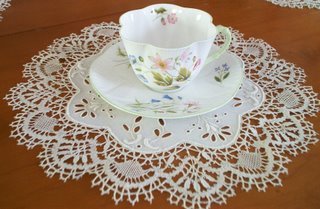indulge fanciful imaginations
invoke illusion
implore forgiveness
inspire innovation
improve (dance better, he said)
in
-print in-the-pink and in-loveA journal of what inspires me





The day I found woad plants for sale, I shouted with joy as they are not commonly found in garden centers. In fact, I never had seen it growing before that day! Although some people consider woad a pervasive weed, it was the northern European version of indigo, used mostly by the early celts who painted their bodies with it before going naked, or nearly so, into battle.
The results of these vegetable dyes are a wonderfully soft palette of earthy colors ~~ not highly saturated. But they are color fast because of the mordants used.
 I took this photo at the San Antonio Central Public Library in February.
I took this photo at the San Antonio Central Public Library in February.This is what coming home looks like.


Here is the entire "piece of beaded cloth".
It is tiny, a mini-beaded quilt only about 6x7 inches.
I haven't put a back on it yet and need to decide what type of hanger to apply.
 will bring joy to your life today? Me, myself and Larry are making a picnic lunch. Going to the beach at noon for our first of the season.
will bring joy to your life today? Me, myself and Larry are making a picnic lunch. Going to the beach at noon for our first of the season.
 Here is an African-Inspired Crazy Quilt that I've been working on this week. I'm calling it, Kitambaa (piece of cloth in Swahili).
Here is an African-Inspired Crazy Quilt that I've been working on this week. I'm calling it, Kitambaa (piece of cloth in Swahili).
 This is a close up of her face
This is a close up of her face A heavy linen laundry bag with a draw string
A heavy linen laundry bag with a draw string
on which someone lovingly embroidered
the floral design and the word "Laundry".
These women seemed to like naming their things!
 This textile is probably early bark cloth
This textile is probably early bark cloth
about 24 inches wide by 36 inches long.
A pocket at the top is to insert tubular cardboard.
I don't know what it was called but it was used to store linens
which were laid upon it and rolled up.
A ribbon at the top was tied to secure the package.
Linen is a brittle fiber;
folding for long periods causes the fibers to break.
Knowledgeable housewifes of the 19th and 20th centuries
devised ways to protect their precious commodities.
 Here is a closeup of one block of an early 20th century quilt.
Here is a closeup of one block of an early 20th century quilt.
Entirely hand-pieced and hand-quilted.
 This is one of a set of tea towels for each day of the week.
This is one of a set of tea towels for each day of the week.
The scene is a common depiction in the first half of the 20th century.
 This is a piece of ethnic embroidery on linen.
This is a piece of ethnic embroidery on linen.
It is probably European and has an art deco feel to me.
 I love this linen and lace tea time placemat
I love this linen and lace tea time placemat These pieces did not come to me in pristine condition.
With few exceptions they were soiled, stained, musty and dusty.
I soak each piece in sodium perborate that I purchase thru a chemical shop on-line
sometimes for days
before drying and ironing
(no never in the dryer!).
Sometimes a piece falls apart in the bath
but mostly they come clean, sparkling, fresh
and ready to grace another table, bed or whatever.
I cherish hand-embroidered Madeira sheets and pillowcases from Portugal
an Edwardian-era silk cape for a child.
Two that did come to me in "as new" condition:
a banquet cloth with elaborate cutwork
of dancing women, musicians and 24 matching napkins in 2 sizes
&
a silk damask lined bedspread that is sooooo beautiful.
And on and on.....
Working with antique linens is a labor of love and a patient rescue operation.
It is impossible to do it without a deep respect for the textile,
its history and graceful design and the woman/women who executed it.
